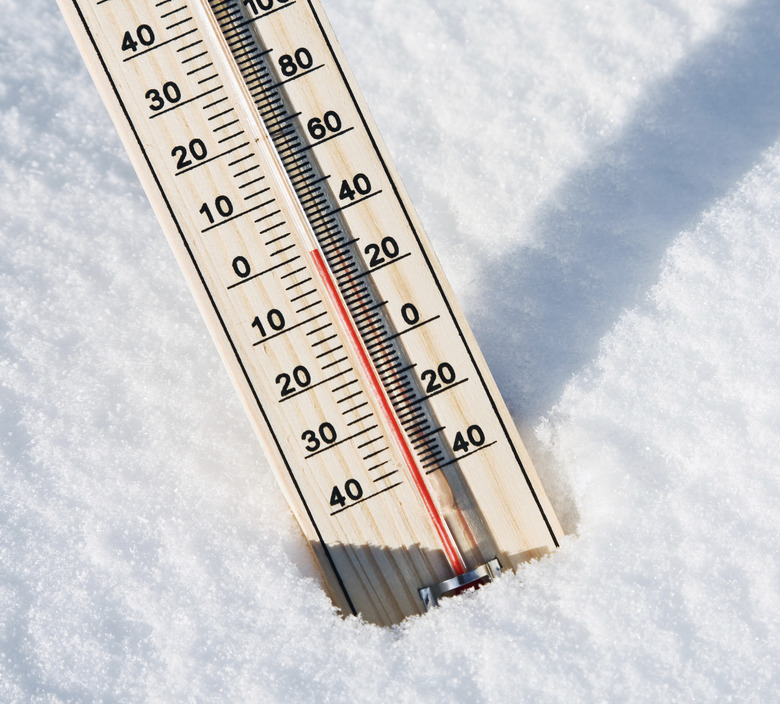Activities For Teaching Hot & Cold Temperature
Children know if something is hot or cold. From an early age, they are told not to touch a hot stove and to wear a coat when it's cold outside. This understanding of temperature is a good starting point to teach the differences in temperature.
Hot or Cold
Hot or Cold
Help the students connect their knowledge to new information. Teach them to recognize hot and cold temperatures on a thermometer. Draw a picture of two thermometers on a white board or chalkboard. Have one thermometer show less than 32 degrees Fahrenheit, and the other 80 F or higher. Explain that the hotter the temperature, the higher the number. Then, point to the "cold" thermometer and discuss what you would do if the outdoor temperatures are below 32 F. Students might suggest things like play in the snow, wear a hat or go ice skating. Do the same with the "hot" thermometer. For older children, change the temperatures of the thermometers and ask them to describe what the weather might look like and how people would dress at certain temperatures, and what kinds of activities people might participate in when it's mild, hot or cold outside.
A Matter of Change
A Matter of Change
Older students can benefit from a lesson that shows how temperature changes the state of matter. Explain that matter is either in a solid, a liquid or a gaseous state. Heat will change the physical state, whether you add heat or take it away. Heat or its absence causes the particles in matter to move in different ways. Heat is energy and when energy moves into an object, the object's particles start moving faster. When heat moves out of an object, the particles slow down. A simple activity is to measure the temperature of ice as it melts. Explain that ice is water in solid form. Have the students place a thermometer against an ice cube and record the temperature of the ice. Then, tell the students to set the ice cube out in the sun. Once the ice cube has partially melted, have the students place the thermometers on the ice cube and record its temperature. When the ice has melted, have them record the temperature of the water. Explain that the freezing point of water is 32 F or 0 C, and that temperatures above freezing will cause ice to melt, changing water from a solid to a liquid. Extend the activity by heating the water to boiling and taking the temperature of the water just as it begins to boil. Use a candy thermometer. Take the temperature yourself — do not let children handle a thermometer near boiling water. Explain that water boils at 212 F or 100 C. Continue to let the water boil until steam rises from the pot, so the students can see how water changes from a liquid to a gaseous state.
Temperature Match
Temperature Match
Discuss home safety when it comes to hot temperatures. Discuss things that are dangerous, such as hot stoves and fireplaces. Talk about how many food items are baked at temperatures of 350 F, such as pies and chocolate-chip cookies. Warn students that water can get very hot and can cause third-degree burns when it reaches a temperature of 140 F, which is well before water boils. Then, have them draw a picture of a room in their house — perhaps a kitchen — and label some of the things that have hot and cold temperatures. For example, the students might write "32 F" next to the freezer and "350 F" next to an oven. Older children might extend the activity by designing posters to remind home owners to set the water temperature on the hot water heater to 120 F, rather than at 140 F.
Weather and Temperature
Weather and Temperature
When it comes to temperatures, nothing fascinates children more than what the temperature is like out of doors. Obtain a report on the yearly weather patterns in your city. The report should include average highs, lows and record-setting temperatures. Then, use that data to teach a math lesson. For example, tell the students what the average high and low temperatures are in your city each year, then ask the students to estimate what the record high in your city has been to date. Graph the responses and then see how far off or close to the mark the estimates were. Or choose a month and graph the average highs and lows, and then find the mean and median.
Cite This Article
MLA
Sanders, April. "Activities For Teaching Hot & Cold Temperature" sciencing.com, https://www.sciencing.com/activities-teaching-hot-cold-temperature-8115744/. 24 April 2017.
APA
Sanders, April. (2017, April 24). Activities For Teaching Hot & Cold Temperature. sciencing.com. Retrieved from https://www.sciencing.com/activities-teaching-hot-cold-temperature-8115744/
Chicago
Sanders, April. Activities For Teaching Hot & Cold Temperature last modified March 24, 2022. https://www.sciencing.com/activities-teaching-hot-cold-temperature-8115744/
